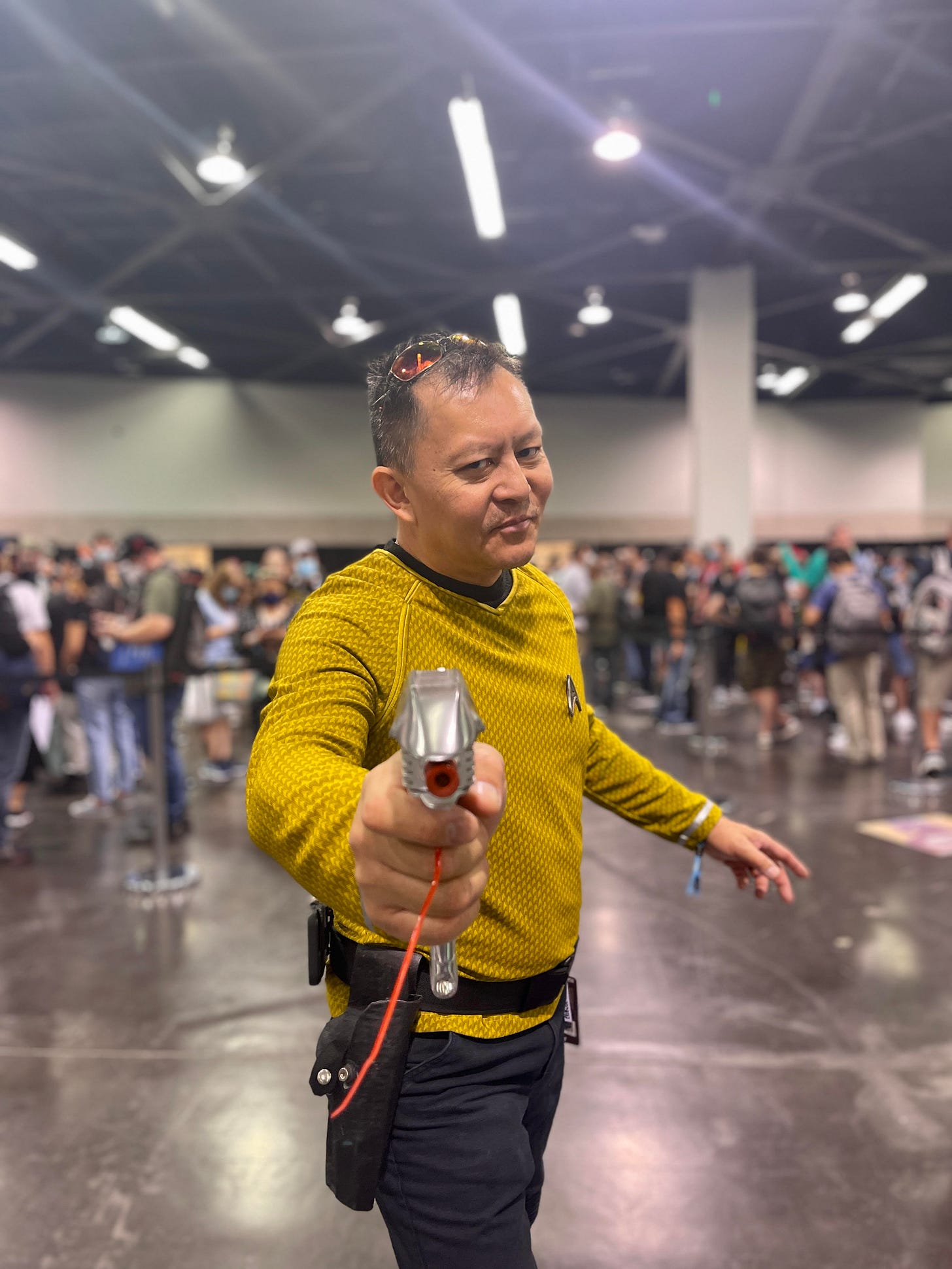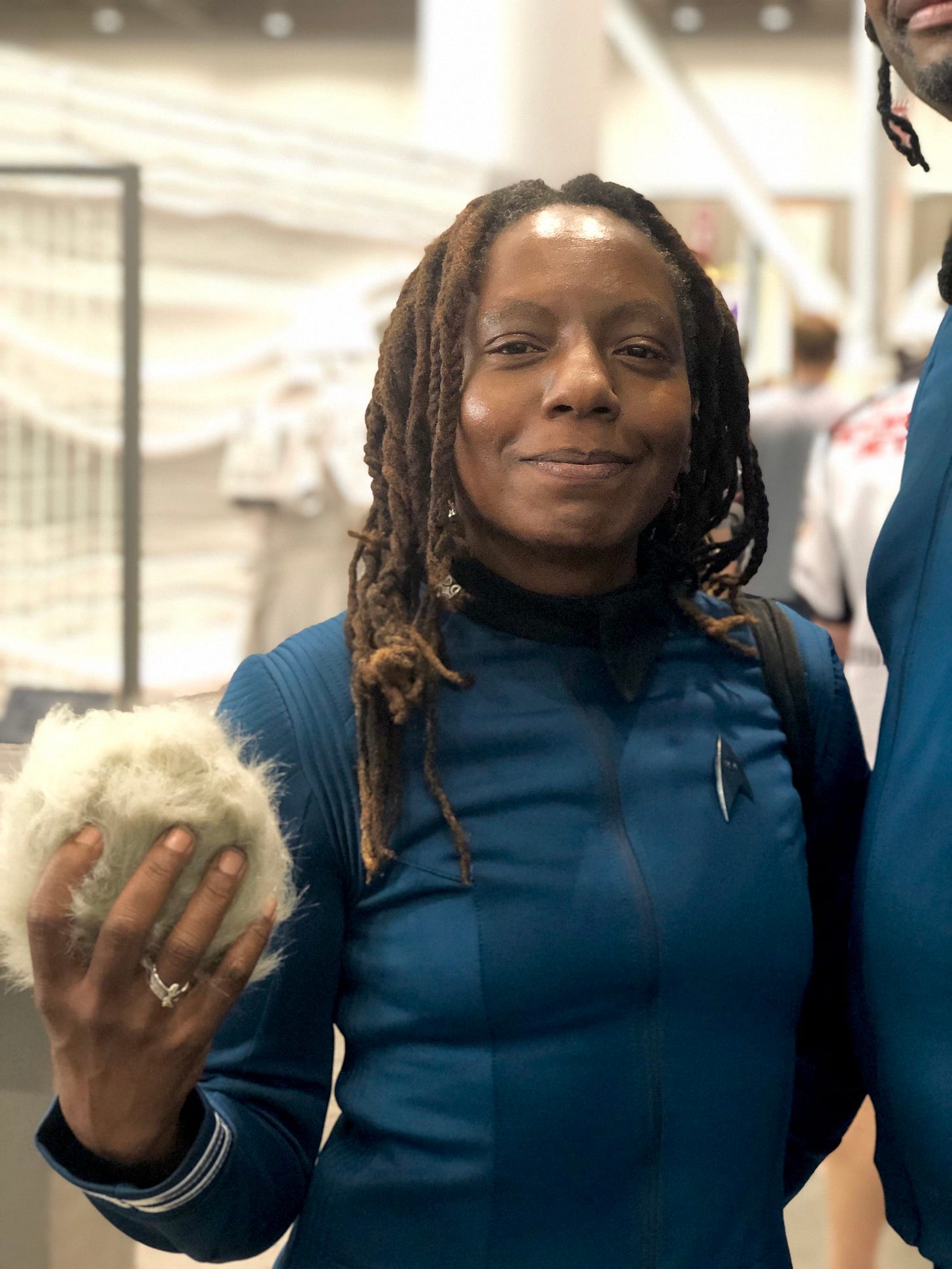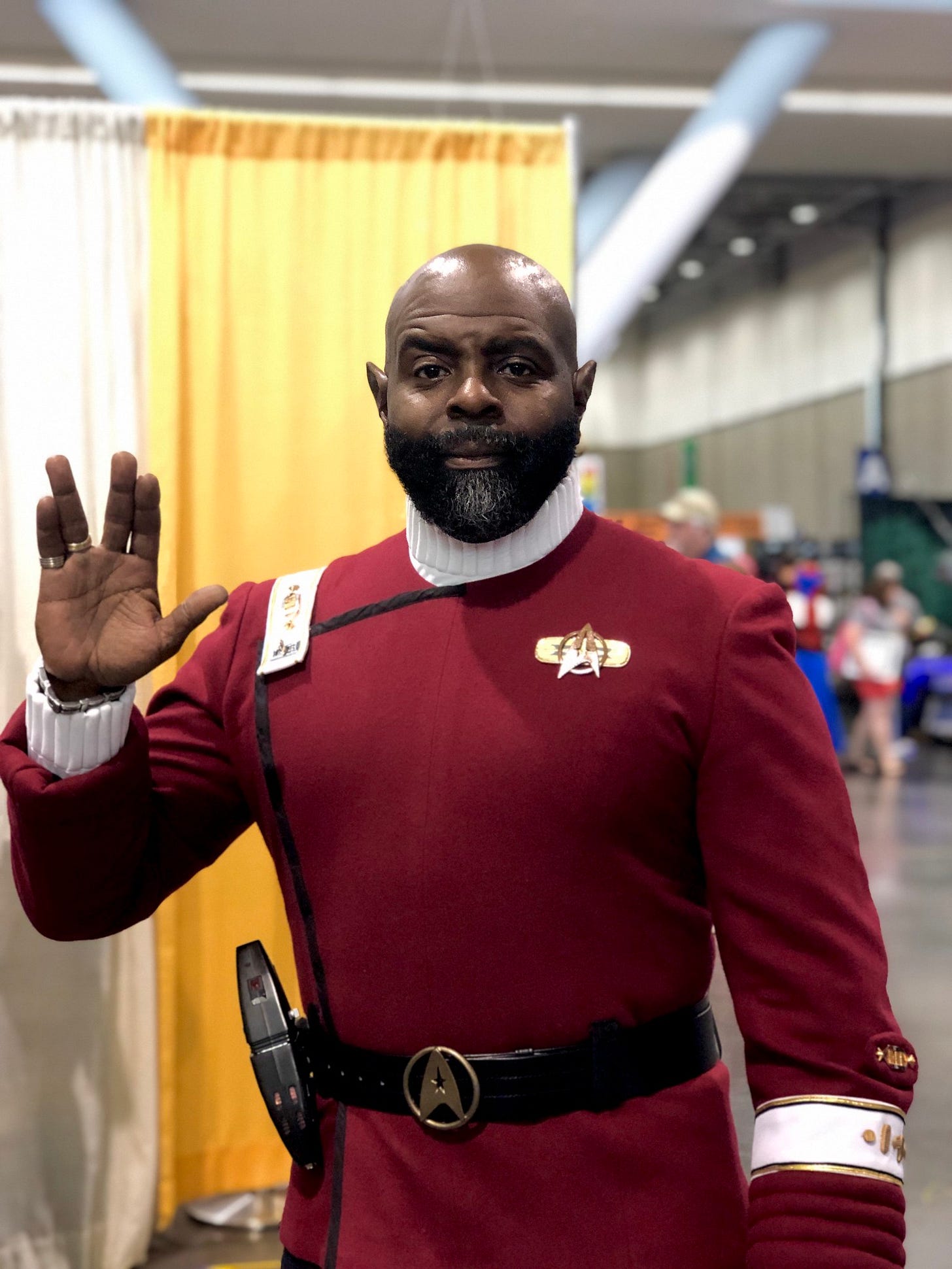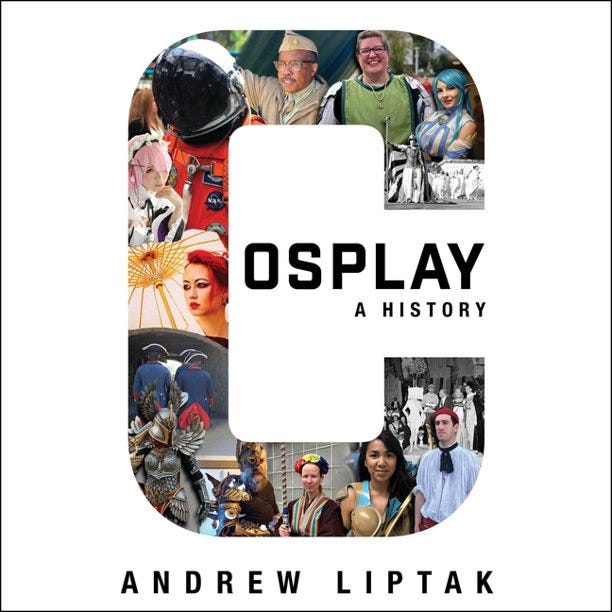Welcome to Star Trekking, my attempt to share points of interest and random intersections in the final frontier.
I’ve been a subscriber to Andrew Liptak’s sci-fi newsletter, Transfer Orbit, since issue #1. In it, he hosts interviews, shares in-depth news and reviews, and generally just provides a worthy dose of sci-fi culture goodness.
He also shares plenty of photos of himself in stormtrooper armor. Yep, Andrew is a cosplayer. And he’s combined his love of costumes and sci-fi in his new book, COSPLAY: A HISTORY, coming June 28 from Saga Press.
I asked Andrew to tell us about the book and what gems Trek fans in particular might find inside.
Andrew in action - from his newsletter. All photos below provided by Andrew.
First off, tell us a little about the genesis of the book.
Back in 2016, the editor of Saga Press, Joe Monti, got in touch with me. We’d known each other through the SF/F field, where I’d worked as a reviewer and commentator for a bunch of places, and noted that he’d just come back from San Diego Comic-Con. He had heard the story of a member of the 501st Legion who’d marched 501 miles to the con to honor his wife, who’d recently died, and wanted to know if there was any sort of story to write about there. We talked, and I went off and put together a outline for a potential book, one that outlined the entire history of the 501st Legion.
The 501st, if you haven’t heard of it, is a world-wide Star Wars costuming organization that focuses on replicating the bad guys that you see on screen. I’ve been a member since 2003 or 2004, dressing up as a stormtrooper (A New Hope and Empire Strikes Back), a clone trooper (Attack of the Clones), and more recently, a First Order heavy stormtrooper (The Force Awakens), and a shoretrooper (Rogue One). So, this was an interesting and appealing concept!
For a bunch of reasons, that book didn’t go anywhere, and as I worked on refining the concept, I realized that in order to tell the story of the 501st, I had to talk about the rest of cosplay in a more holistic manner. I got a new agent, retooled the entire concept, and repitched it to Saga, who picked it up. We announced the book as I was leaving Star Wars Celebration in 2019, and I spent the rest of the year working on visiting various cons and conducting interviews.
The first Star Trek conventions are legendary for their unexpectedly enormous crowds as well as for the creativity of the costumes. What did you learn about cosplay in those early days of Trek fandom? How big a role does Trek play in the overall arc of cosplay history?
Working on the book has been full of unexpected things to learn. I’ve been a casual fan of Star Trek: I’ve broadly sampled it, but never really dove head-first into any of the shows or movies (although Lower Decks has become a real favorite.) I’ve also been broadly familiar with the history of Star Trek, but it wasn’t until I started really digging into the history of fandom that I fully realized how much of a lightning strike that original series was back in 1966: it changed the entire face of fandom.
Up until that point, SF Fandom was primarily a literature-based thing. Folks read stories in magazines and then books. The TV shows and movies just didn’t live up to their expectations, and those productions really didn’t appeal to a mass audience. Star Trek introduced a huge segment of the public to science fiction, in its original run and then through syndication, and brought enormous crowds into the ranks of fans. It brought more women in, and by extension, things like fan fiction and costuming into a wider use.
Costuming had been a staple of SF cons up to that point, but they were largely restricted to just the last day of the con, for specific events, like a party or costume masquerade. That makes sense! You might be bringing something complicated, and you don’t want to wear it around. Star Trek uniforms and costumes? Generally comfortable, and people started wearing them around the convention. One of my interviewees, Astrid Bear, who has been around conventions for decades, noted that a lot of people referred to it as Hall Costuming (sometimes condescendingly!), and there was some tension between the traditional fans and the folks doing this.
Star Trek also helped fragment the idea of fandom as this one unified community into smaller subsections that focused on specific things. You see the rise of dedicated fan communities spring up for these big franchises, like Trek, Star Wars, Babylon 5, Stargate, or Battlestar Galactica, and so forth. Star Trek, in many ways, helped lead to the modern con environment, where you have people attending purely because they’re attending in costume.
What were some of your primary resources for researching cosplay?
There were a bunch of things that I relied on. First and foremost, I went to cons, met folks, and conducted interviews in person and over the phone. I tried to get a broad swath of folks who had been involved in various places: Art Andrews of the Replica Props Forum, Adam Savage, the former Mythbusters co-host (who ended up writing the foreword!), Albin Johnson (founder of the 501st), Bear, and a whole bunch of other folks. They provided some really good insights into the way that they took part in the hobby, and how their actions helped influence the field. There were also a lot of folks that I tried to get in touch with but never heard back from, but tried to capture their stories or influence through secondary sources. Along the way, I took a lot of pictures that ended up in the book.
Other primary sources that were absolutely vital: Fanac.org is a website that serves as an online archive for the history of fandom by preserving a lot of those original documents about cons, pictures, and so forth. I found tons of convention reports and updates that singled out costuming and cosplay as major elements, and it was fascinating to read through them to see what people thought about the hobby, and how it took root in the SF con scene over the 1940s and 1950s.
There are other folks too: Bear, John Coker III, and Carol Resnick provided a bunch of historical pictures to use, which helped provide a good window into the nature of the world of fandom. There was also the archives at UC Riverside, which have a phenomenal collection of photographs from throughout the history of fandom — which I found too late to really delve into to use for the book, but I was able to license a couple to use that made it in.
Tell us a little about the look and feel of the book overall - is it a narrative history, are there a lot of photos?
It’s a bit of both! I approached the text as a bit of a narrative, and we start way back in the 1700s to look at early examples of costuming and how that grew with time into the era of SF fandom, and then how the hobby morphed with time to what it is today.
I wanted to approach this holistically: rather than a beat-by-beat narrative about how cosplay changed with time, I wanted to answer the question as to why it has become a large, mainstream phenomenon — something it wasn’t when I started! I take detours into how a whole bunch of elements come together to form the modern field: how 3D printing came about, the social networks that help fuel its growth, the state of the entertainment industry, and so forth.
And, along the way, there are lots of pictures! I took a ton of them for the book while I visited cons, licensed others, had folks donate them, and went to archival images in the public domain. I don’t remember the exact number, but there’s around 150 or so? There was also a lot set up on the cutting-room floor, and I’m thinking of sticking some of the ones that I took into a folder to supplement the text for newsletter subscribers or something.
You present yourself as mostly a Star Wars guy, cosplay-wise. What is your own personal history with Star Trek and Trek costuming?
I don’t have much of a history with Star Trek, sadly, although when I went to Star Wars Celebration last month, I picked up and wore a DISCO shirt from Discovery.
I also saw a handful of folks dressed up as Starfleet officers, which was delightful. I have thought about picking up an officer’s tunic from the JJ Abrams films — I really like that look. I’m also starting to really enjoy Strange New Worlds, so I’m definitely considering one of those uniforms for some future con.
Were there any big surprises you uncovered or rabbit holes you didn't expect to fall into while researching the book?
I mean, this entire book is a rabbit hole! There are so many little moments that I found that were just so fascinating that I ended up tracking down more than I ever imagined. One good example is that I found that Trick or Treating was something that largely happened around Thanksgiving, not Halloween, especially around the New York metropolitan area, and it only really shifted because of the commercial efforts from candy and costuming makers around the 1930s/1940s into the post-war era.
I think the biggest revelation that I had while writing this book is that it’s a story about how a community of positive, enthusiastic folks came together over generations, and that there’s an economic element to this: cosplay has grown because it’s become easier to access. One good example: 3D printers have become much cheaper because patents expired on the original technologies, meaning that they’re easier and cheaper to buy. Folks make crazy, amazing costumes out of foam because someone (an internet user nicknamed penwiper) put together tutorials that showed people how to make armor out of it. And you can learn anything you’d ever need to make anything you’d ever want because of sites like YouTube, which have millions of hours of tutorials of people building stuff.
COSPLAY: A HISTORY is available for pre-order.
I encourage you to subscribe to Andrew’s excellent newsletter, Transfer Orbit. Additionally, you can find Andrew on Twitter and at his own website, andrewliptak.com. And he’ll be appearing at this year’s Trekonderoga, so if you’re there, make sure you flash him a Vulcan salute from me!
Thanks, Andrew!
And if you aren’t already a subscriber to this newsletter, well, have I got a button for you to push:
Until next time, remember -
The human adventure is just beginning.








